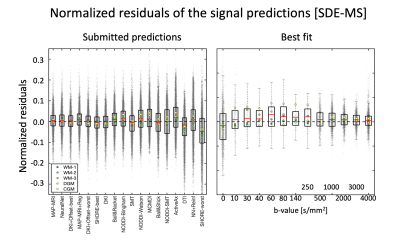Alberto De Luca1,2, Andrada Ianus3,4, Alexander Leemans2, Marco Palombo5, Hui G Zhang5, Daniel C Alexander5, Markus Nilsson6, Geert-Jan Biessels1, Mauro Zucchelli7, Matteo Frigo7, Enes Albay7,8, Sara Sedlar7, Abib Alimi7, Samuel Deslauriers-Gauthier7, Rachid Deriche7, Rutger Fick9, Maryam Afzali10, Tomasz Pieciak11,12, Fabian Bogusz11, Santiago Aja-Fernandez12, Evren Özarslan13,14, Derek K Jones10, Haoze Chen15, Mingwu Jin16, Zhijie Zhang15, Fengxiang Wang15, Vishwesh Nath17, Prasanna Parvathaneni18, Jan Morez19, Jan Sijbers19, Ben Jeurissen19, Shreyas Fadnavis20, Stefan Endres21, Ariel Rokem22, Eleftherios Garyfallidis20, Irina Sanchez23, Vesna Prchkovska23, Paulo Rodrigues23, Bennett A Landman24, and Kurt G Schilling24
1Department of Neurology, University Medical Center Utrecht, Utrecht, Netherlands, 2PROVIDI Lab, Image Sciences Institute, University Medical Center Utrecht, Utrecht, Netherlands, 3Champalimaud Research, Champalimaud Centre for the Unknown, Lisbon, Portugal, 4Centre for Medical Imaging Computing, University College London, London, United Kingdom, 5Centre for Medical Image Computing, University College London, London, United Kingdom, 6Clinical Science, Department of Radiology, Lund University, Lund, Sweden, 7Inria Sophia Antipolis – Méditerranée, Université Côte d'Azur, Sophia Antipolis, France, 8Istanbul Technical University, Instanbul, Turkey, 9Therapanacea, Paris, France, 10Cardiff University Brain Research, Imaging Centre (CUBRIC), School of Psychology, Cardiff University, Cardiff, United Kingdom, 11AGH University of Science and Technology, Krakow, Poland, 12LPI, ETSI Telecomunicacion, Universidad de Valladolid, Valladolid, Spain, 13Department of Biomedical Engineering, Linköping University, Linköping, Sweden, 14Center for Medical Image Science and Visualization, Linköping University, Linköping, Sweden, 15School of Instruments and Electronics, North University of China, Taiyuan, China, 16Department of Physics, University of Texas at Arlington, Arlington, TX, United States, 17NVIDIA Corporation, Bethesda, MD, United States, 18National Institute of Neurological Disorders and Stroke, National Institute of Health, Bethesda, MD, United States, 19Imec-Vision Lab, Department of Physics, University of Antwerp, Antwerp, Belgium, 20Intelligent Systems Engineering, Indiana University Bloomington, Bloomington, IN, United States, 21Leibniz Institute for Materials Engineering - IWT, University of Bremen, Bremen, Germany, 22Department of Psychology and the eScience Institute, University of Washington, Seattle, WA, United States, 23QMENTA Inc, Barcelona, Spain, 24Institute of Imaging Science, Vanderbilt University, Nashville, TN, United States
1Department of Neurology, University Medical Center Utrecht, Utrecht, Netherlands, 2PROVIDI Lab, Image Sciences Institute, University Medical Center Utrecht, Utrecht, Netherlands, 3Champalimaud Research, Champalimaud Centre for the Unknown, Lisbon, Portugal, 4Centre for Medical Imaging Computing, University College London, London, United Kingdom, 5Centre for Medical Image Computing, University College London, London, United Kingdom, 6Clinical Science, Department of Radiology, Lund University, Lund, Sweden, 7Inria Sophia Antipolis – Méditerranée, Université Côte d'Azur, Sophia Antipolis, France, 8Istanbul Technical University, Instanbul, Turkey, 9Therapanacea, Paris, France, 10Cardiff University Brain Research, Imaging Centre (CUBRIC), School of Psychology, Cardiff University, Cardiff, United Kingdom, 11AGH University of Science and Technology, Krakow, Poland, 12LPI, ETSI Telecomunicacion, Universidad de Valladolid, Valladolid, Spain, 13Department of Biomedical Engineering, Linköping University, Linköping, Sweden, 14Center for Medical Image Science and Visualization, Linköping University, Linköping, Sweden, 15School of Instruments and Electronics, North University of China, Taiyuan, China, 16Department of Physics, University of Texas at Arlington, Arlington, TX, United States, 17NVIDIA Corporation, Bethesda, MD, United States, 18National Institute of Neurological Disorders and Stroke, National Institute of Health, Bethesda, MD, United States, 19Imec-Vision Lab, Department of Physics, University of Antwerp, Antwerp, Belgium, 20Intelligent Systems Engineering, Indiana University Bloomington, Bloomington, IN, United States, 21Leibniz Institute for Materials Engineering - IWT, University of Bremen, Bremen, Germany, 22Department of Psychology and the eScience Institute, University of Washington, Seattle, WA, United States, 23QMENTA Inc, Barcelona, Spain, 24Institute of Imaging Science, Vanderbilt University, Nashville, TN, United States
Existing diffusion MRI models can generally well predict single diffusion encoded data given a training subset, except for low and very strong weightings, whereas the accurate prediction of double (oscillating) diffusion encoding data is challenging.

Figure 2: Left) Boxplots of the normalized residuals (gray dots) of each prediction of SDE-MS data, when pooling together all 5 signals. Right) The normalized residuals of the best prediction (MAP-MRI) over individual diffusion weightings. The red asterisks on the left panel indicate predictions significantly different from the best prediction, whereas those on the right indicate that residuals at a specific diffusion weighting show a significantly non-zero mean.

Table 1: The valid signal predictions submitted to the MEMENTO challenge. For each method, we report the acronym and the main reference, the “category”, special notes on the fit procedure, and the data it has been applied to. The following predictions were subdivided in the following categories: tensor-based (TENS), multi-compartment model (MCM), parametric representation (PAR), deep learning-based (DL).